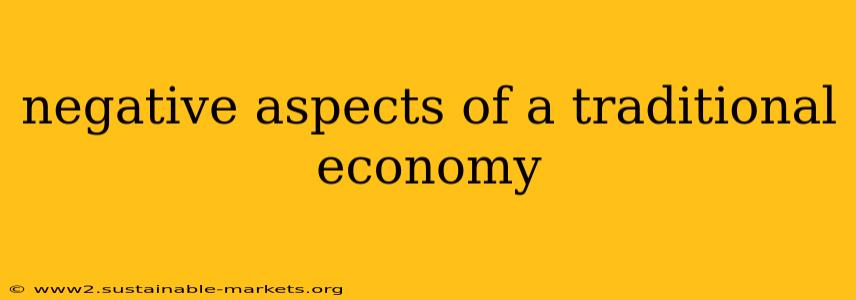Traditional economies, rooted in customs and history, offer a captivating glimpse into a simpler way of life. However, beneath the surface of self-sufficiency and community lies a reality often marked by limitations and challenges. While romanticized in some narratives, understanding the negative aspects of a traditional economy is crucial for a balanced perspective. This exploration delves into the key drawbacks, providing a nuanced understanding of this economic system.
Limited Technological Advancement
One of the most significant drawbacks of a traditional economy is its inherent resistance to technological innovation. Reliance on age-old methods, passed down through generations, often stifles the adoption of new technologies that could boost productivity and efficiency. This resistance stems from a deep-rooted cultural attachment to established practices, making the transition to modern techniques a slow and challenging process. The lack of investment in R&D further exacerbates this issue, resulting in a slower pace of economic growth compared to market-based economies.
Stagnant Economic Growth and Low Standard of Living
The absence of technological advancement directly translates to stagnant economic growth. Traditional economies often struggle to produce surpluses beyond immediate needs, leading to a lower standard of living compared to modern economies. Limited opportunities for specialization and division of labor result in lower overall output and a less diverse range of goods and services available to the population. This can lead to widespread poverty and limited access to essential resources such as healthcare and education.
Vulnerability to External Shocks
Traditional economies are highly vulnerable to external shocks, be it natural disasters or fluctuations in global markets. Their dependence on local resources and limited diversification means that a single adverse event can have a devastating impact on the entire economy. For example, a poor harvest can lead to widespread famine, while a decline in demand for a specific locally produced good can cripple the livelihoods of many. The lack of safety nets and social security systems further intensifies the impact of these shocks.
Lack of Economic Mobility and Opportunity
The rigid social structures inherent in many traditional economies severely limit economic mobility and opportunity. Individuals are often locked into their inherited roles, with little chance of improving their socio-economic status. This can lead to social inequality and a lack of incentive for individuals to pursue education or acquire new skills, further hindering economic development. The absence of a meritocratic system perpetuates a cycle of poverty and limits overall societal progress.
Inefficient Resource Allocation
Traditional economies often demonstrate inefficient resource allocation. Decisions regarding production and distribution are primarily driven by customs and traditions rather than market forces, leading to potential surpluses or shortages of goods and services. The lack of a price mechanism to signal scarcity or abundance results in misallocation of resources and hinders optimal economic efficiency. This can lead to waste, reduced productivity, and missed opportunities for economic growth.
Environmental Concerns
While some may view traditional economies as more environmentally friendly, the reality is often more complex. Unsustainable agricultural practices, deforestation, and overexploitation of natural resources are common occurrences in some traditional economies driven by immediate survival needs. The absence of environmental regulations and a long-term perspective can lead to significant environmental degradation and depletion of resources for future generations.
Conclusion: A Balanced Perspective
The negative aspects of a traditional economy are undeniable. However, it's important to note that this is not a blanket condemnation. Many traditional economies offer valuable lessons in community cohesion, sustainable living, and a deeper connection to the natural world. The challenge lies in finding a balance—integrating elements of modernization and innovation while preserving the positive aspects of traditional practices. Understanding both the strengths and weaknesses provides a more complete picture and allows for informed discussions about economic development and societal well-being.

